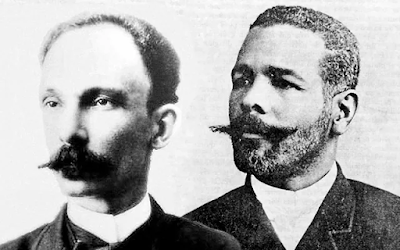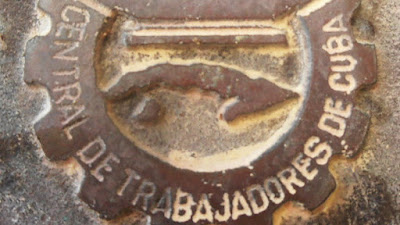"Terrorism and deception are weapons not of the strong but of the weak." - Mohandas Gandhi
 |
| Officials from state terror sponsors shouldn't be given tours of secure facilities |
WLRN Americas Editor Tim Padgett's latest column "What's outrageous in Miami is the outrage — and TSA's Cuba optics" is an example of a lack of seriousness.
Jesse Scheckner writing in Florida Politics on the visit of Cuban officials to Miami International airport on May 20th provided important context: "The tour also happened just under five years after reportedly leaked Cuban intelligence showed that spies at MIA had stolen security codes and other confidential information."
There are also a number of reasons why the United States, or any sane country for that instance, would think twice about "cooperating" with the Cuban dictatorship in the fight against terror [or for that matter against drug trafficking].
Consider the following omitted by Mr. Padgett about the Cuban government currently in power.The dictatorship in Cuba led by the Castro brothers came to power through a campaign of urban terrorism carried out by the July 26th Movement in the 1950s against the dictatorship of Fulgencio Batista.
 | ||
| One of nine bombs placed in Havana by Fidel Castro's July 26 movement in El Collar store on Aguila St. in Aug 1957 |
Throughout the 1950s, Castro's July 26th Movement carried out multiple bombings terrorizing and killing Cuban civilians.
Fidel Castro ordered the burning of Cuban sugar mills, warehouses, busses, and factories. He also ordered bombings of stores, theaters, nightclubs, and clinics around the island as part of the revolution against the Batista dictatorship. In 2015, the Office of Publications of Cuba's Council of State produced a four-volume chronology titled "We shall fight until the end" [Lucharemos Hasta el Final].
According to the 1958 volume, in May of that year "electric transformers that provided electricity to Santiago de Cuba, El Cobre and Contramaestre were blown up [by Castros' forces] leaving important urban areas without electricity ...". In Havana, a member of Castro's 26 of July Movement is killed when he was "surprised setting up a bomb." In "Santiago de Cuba, two rebels fired against a government soldier in the intersection of Trocha and Corona streets. The soldier was seriously wounded."
Two rebels set on fire furniture store' La Caridad". In "Ramon de las Yaguas neighborhood" in Oriente province "an activist from a government political party (PURS) is murdered." A revolutionary died when a bomb he was placing in front of a movie theater in Marianao (Havana province) went off. And earlier this month a town near Santiago was left without electricity due to sabotage carried by rebel forces.
These are some of the terrorist attacks carried out during the month of May 1958. The number of such crimes which took place during 1955,1956,1957 and 1958 were chronicled in 2015 by the Office of Publications of Cuba's Council of State. The many innocent victims and millions of property loses demonstrate without a doubt the mendacity of Fidel Castro's claim that "the Cuban revolution never engaged in terrorism."
Raul Castro, considered by some as ‘the father’ of the modern crime of skyjacking, plotted several skyjackings. One skyjacking resulted in the deaths of 17 civilians on November 1, 1958.
Once the Castro brothers took power, and consolidated their rule through a campaign of revolutionary terror that included mass executions, they turned their attention to international terrorism, and promoting it as a necessary tactic for revolutionaries.
Castroism views terrorism as a legitimate tactic to advance its objectives. Havana published the "Mini Manual of the Urban Guerilla" by Carlos Marighela. Translated into many languages, it contains a chapter on terrorism that states: "Terrorism is a weapon the revolutionary can never relinquish."
The Castro brothers created a terrorist international.
The Tricontinental Conference held in Havana from January 3-16, 1966, and the creation of Organization for the Solidarity of the Peoples of Asia, Africa and Latin America (OSPAAL) sought to support terrorist groups worldwide. “Castro insisted that ‘bullets not ballots’ was the way to achieve power.” He maintained “‘conditions exist[ed] for an armed revolutionary struggle.’
 |
| Carlos the Jackal trained in Cuba. |
Ilich Ramírez Sánchez (age 17) attended the 1966 Conference. Afterwards, Ilyich spent the summer at Camp Matanzas, a guerrilla warfare school run by the Cuban DGI. Following a string of terrorist attacks, he picked the alias “Carlos. France expelled three high‐ranking Cuban diplomats on July 10, 1975. ”The Cubans, according to the French Interior Ministry, were “constant visitors” to the Paris hideout of Carlos”
"In the Arab world some 3,000 [Cuban advisers could] be found in Libya and Algeria, among other things training terrorists" in 1988. Havana today collaborates with Hamas and other Middle East terrorists groups.
Concern about Cuban diplomats touring security facilities at an American airport is not an example of post traumatic stress disorder (PTSD), but common sense.
Killing Americans in New York City.
 |
| Aftermath of bombing in Fraunces Tavern in 1975 that killed four. |
The Puerto Rican terrorist group, Fuerzas Armadas de Liberación Nacional, (FALN) carried out more than 130 bombings. The FALN is responsible for:
the 1975 explosion at Fraunces Tavern, killing four and wounding 63 others.
A bombing spree in New York City in August 1977 that killed one, injured six, and forced the evacuation of 100,000 office workers;
and the purposeful targeting and maiming of four police officers.
FALN was started in the mid-1960s and received advanced training in Cuba.
 |
| Frank Connor killed in Frances Tauvern by Cuban trained terrorists |
Samuel T. Frances in his 1979 essay “Latin American Terrorism: The Cuban Connection” published by The Heritage Foundation found that "[a]lmost every significant Latin American terrorist group of left-wing orientation has had or has today links with Cuba.”
Cuba was placed on the list of state terror sponsors on March 1, 1982.
The US State Department confirmed Havana was using a narcotics ring to funnel arms and cash to the Colombian terrorist group M-19. Three years later on November 6, 1985, M-19 members stormed Colombia’s Palace of Justice. This attack led to many hostages killed, including 11 of the Colombian supreme court’s 25 justices. It is a perverse irony that the election of former M-19 terrorist Gustavo Petro to the Colombian presidency, and his subsequent request to rescind extradition requests for ELN guerillas housed by Cuba for a 2019 terrorist attack is part of the reason that the State Department is now saying that Havana is fully cooperating in anti-terrorism efforts.
The Cuban dictatorship has carried out acts of state terrorism against Cuban nationals including killing dozens of men, women, and children on July 13, 1994. Fidel Castro, in the case of the "13 de marzo" tugboat massacre, then defended and celebrated the men responsible for the massacre declaring their actions to be "exemplary, there's no denying it."
Spy network plots murder of Americans in coordinated attack.
The WASP Network (La Red Avispa) targeted U.S. military facilities, planned to smuggle arms and explosives into the U.S.,among other active measures. Havana carried out Operation Scorpion, an act of state terrorism using its WASP spy network in the United States that killed four in international airspace on February 24, 1996.
 |
| 10 captured members of the WASP spy network. |
The Castro regime's embrace of terrorism has caused unexpected blowback for the dictatorship. According to Havana, the October 6, 1976 bombing of Cubana airlines flight 455 that caused the deaths of 73 passengers was the work of two Cuban exile terrorists.
Mr. Padgett ends his column citing this act of terrorism as follows.
"Still, all those outraged Miami politicos who are sure TSA exposed MIA to the DGI (Cuba’s spy service) might themselves remember Cuba also has aviation security concerns. It has ever since Cuban exile terrorists carried out the 1976 bombing of a Cuban passenger airliner that killed all 73 people onboard. That, too, was an outrage."
Yes it is, but what both he and the Cuban dictatorship omit is that the two Cuban exiles credited for the terrorist attack had first engaged in terrorism for the Castro brothers as members of the July 26th Movement in their struggle against Batista, and turned against the Castros when they imposed a new dictatorship, betraying their promises of a democratic revolution.
 |
| 73 passengers on Cubana airlines flight 455 killed on 10/6/76 |
Padgett also viewed as "good policy" the Biden Administration’s "move a few years ago to take Colombia’s defunct Marxist guerrilla army, the FARC, off the U.S.’s terrorist list" in 2021. Yet so-called "FARC dissidents" continue to carry out terrorist attacks in Colombia in 2024.
Hopefully, the Biden Administration hasn't given FARC terrorists tours of airport and port security around the United States like they have Cuban officials. This is not a question of slighting an ethnic group, or PTSD, but a question of national security.
Thankfully others in the media have taken this matter more seriously.


















